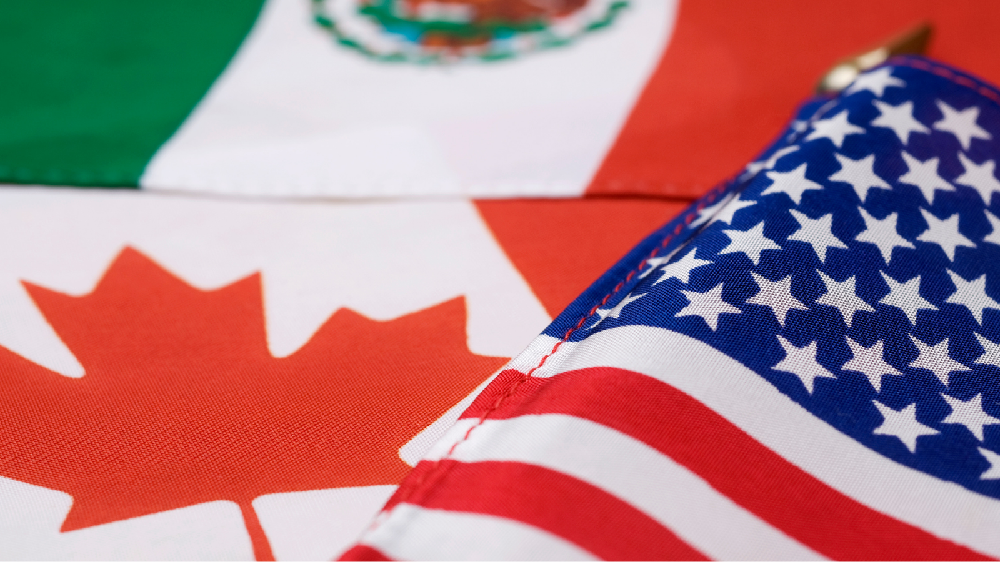
Editor’s note: This content was last updated May, 2024. There are ongoing developments in the trade relationships between CUSMA members that are not reflected in this article.
In July 2021, Mary Ng, Canadian Minister of Small Business, Export Promotion, and International Trade, along with Tatiana Clouthier, Mexico’s Secretary of Economy, and Katherine Tai, United States Trade Representative, marked the one-year anniversary of CUSMA, also known as the Canada-United States-Mexico Agreement. This historic all-female gathering took place in Mexico and saw all three women converge, in person, to mark “their commitment to North American supply chains and economic competitiveness, which have created significant economic growth and benefits for people and workers in all three countries,” according to the official Trilateral Joint Statement.
New 2023 Trilateral Joint Statement
For many, the acronym CUSMA is still not second nature—even prompting some to refer to it as the “New NAFTA” (the North American Free Trade Agreement) or “NAFTA 2.0,”—and there are many reasons for this. For starters, the countries that are part of CUSMA each refer to it differently, with the U.S. calling it “USMCA” and Mexico often calling it “T-MEC.” Beyond the name, the details surrounding CUSMA aren’t as clear-cut as they were with NAFTA (which came into effect January 1st 1994), prompting many questions about the trade agreement that have yet to be answered to this day.
To understand what CUSMA is, the history leading up to its enactment, and where it stands today, read on below:
What is the Canada, United States, Mexico Free Trade Agreement (CUSMA)?
Many refer to CUSMA as the “New NAFTA” or “NAFTA 2.0” because it is largely a revised version of NAFTA. Similar to NAFTA, it is a free trade agreement between Canada, the United States and Mexico that defines the National Treatment and Market Access for Goods between the countries, determining rules and regulations on tariffs, rules of origin, customs administration, trade facilitation, and many other trade-related matters.
The CUSMA trade agreement covers a long list of items, from agriculture and textiles to regulatory matters such as government procurement, macroeconomic policies, Intellectual Property (IP) rights, and rules for Small and Medium-Sized Enterprises (SMEs).
The tumultuous history of CUSMA
CUSMA was created at the insistence of former U.S. President Donald Trump. He was outspoken about his dislike of NAFTA during his presidential campaign and pushed for a new trade agreement that favoured American interests—even going so far as to threaten to terminate the agreement altogether if the other countries did not acquiesce to a new agreement. Unsurprisingly, the negotiations for many of these changes were tense, and leading up to the signing, the U.S. increased the tariffs on specific imports from Canada to the U.S., causing Canada to do the same in retaliation. Mexico also had criticisms of the trade deal agreement in many areas.
Eventually, CUSMA was ratified on March 13, 2020, with Canada being the last country to ratify. Following this, the agreement officially came into effect on July 1, 2020. In a State of the Union Address, former President Donald Trump said of the agreement, “The USMCA will create nearly 100,000 new high-paying American auto jobs, and massively boost exports for our farmers, ranchers, and factory workers. It will also bring trade with Mexico and Canada to a much higher degree, but also to a much greater level of fairness and reciprocity.” Meanwhile, critics noted that Canada, in particular, was consistently treated as an “enemy” instead of a partner throughout the negotiations.
What were the main changes in CUSMA?
To ensure that the new trade agreement was beneficial for all, the participating countries used the new trade agreement as an opportunity to revise items from NAFTA, adding new sections on digital trade, labour, the environment, and small and medium-sized businesses.
Additionally, there were increased incentives for automobile production in the United States, a higher duty-free limit for Canadians who buy goods from the U.S. online, and greater access to the Canadian dairy market from the U.S.—a move which has had large financial repercussions on the Canadian dairy industry. However, many see the provision on labour, especially for workers’ rights in Mexico, as largely positive and progressive.
How is CUSMA doing today?
The views on CUSMA’s impact in North America one year after it came into effect are varied. Many, especially those with U.S. interests, view it as a success, while critics say that other countries were forced to make unfavourable agreements. Currently, there are disputes in several areas including labour rights violations in Mexico and a USMCA dispute panel has been initiated over dairy tariff rate quotas (TRQs) applied by Canada.

Learn more about trade tariffs and quotas in our FITTskills course, Feasibility of International Trade.
To complicate the matter, COVID-19 delayed the implementation of many CUSMA measures, with all countries focusing their efforts on pandemic relief. As such, much of the impact of CUSMA remains to be seen, though, initial predictions found the economic impact to be modest, with Global Affairs Canada projecting that Canada would benefit from CUSMA by 0.249 percent of GDP by 2025 when compared to a scenario without NAFTA in play.
In a news release on the Government of Canada website, there were noted next steps for CUSMA, including the following:
“As our countries continue to combat the COVID-19 pandemic and continue our shared recovery from an economic downturn that has disproportionally impacted SMEs and underrepresented communities, we recognize that the CUSMA has an important role to play in revitalizing our region. As we continue implementing the CUSMA and ensuring that this Agreement benefits those that have historically been left behind by trade agreements, the Parties have agreed to continue to hold engagement meetings with underserved communities and to hold a Trade Deputies meeting before the end of this year to assess progress on the areas highlighted today and identify ongoing opportunities for future engagement.”
CUSMA and SMEs
CUSMA’s chapter on small- and medium-sized commercial goods businesses could be very beneficial for these businesses. The CUSMA additions for SMEs are moving forward with items like establishing a committee that will study how small businesses engage in trade and determining how SMEs in all countries can benefit from the agreement.
This is especially important now, as many SMEs have suffered great financial losses due to the pandemic.
Perhaps on future anniversaries of the agreement, SMEs in all three countries may conclude that the true legacy of CUSMA is that it serves as a catalyst for equitable growth, a model for competitiveness, and a stoke for innovation while also protecting the shared environment in North America.
Decision No. 5 of the FTC of the CUSMA, T-MEC, and USMCA
In February 2023, the Free Trade Commission (FTC) sought to enhance coordination and consultation to support the region’s trade flows in times of emergency, acknowledging how such situations can harm North America’s domestic economies. As such, the FTC required the participating countries to identify relevant agencies or maintain domestic committees to ensure that trade isn’t disrupted, or at least only minimally affected, by emergency situations.
In such events, the United States, Canada, and Mexico must also proactively consult and coordinate with relevant industries and non-governmental stakeholders (including workers) who may be involved, and inform them promptly of important mechanisms on a free and public website for transparency.
The FTC also set to establish a Trilateral Coordination Sub-Committee on Emergency Response to handle the delivery of information and the coordination of activities related to matters affecting trade during an emergency. Each country must designate a contact point for the Sub-Committee, which shall be endorsed to the other countries, and provide information on domestic procedures for emergency responses. The Sub-Committee must then reconvene annually to discuss comprehensive risk management as they see appropriate.
The FTC also directed the North American Competitiveness Committee, through its Sub-Committee, to develop a proposal on procedures for coordination and consultation during specific emergency events. It was also tasked to establish a trilateral Working Group to share each country’s approach to defining and protecting critical infrastructure under CUSMA and to reconvene periodically to update reviews and reports and to make any modifications as appropriate.
In all this, the FTC emphasized the importance of labour rights and worker health and safety, especially in emergency situations. The Sub-Committee must ensure the protection of these while maintaining trade flows.
The Latest on CUSMA in 2023
Three years after CUSMA entered into force, North America has felt the effects of the agreement. These were discussed in the third meeting of the T-MEC/USMCA/CUSMA (Agreement) FTC on July 7, 2023, in Cancun, Mexico.
The last two years have seen aggressive steps towards increasing dynamism and competitiveness in the region, particularly through trilateral workforce development events held in all three participating countries. These gatherings are expected to continue as they present an opportunity for each country to exchange best economic practices and explore solutions to regional and national challenges.
SMEs continue to be a hot topic, as organizations push these businesses (primarily indigenous organizations) to actively participate in international trade, as facilitated by CUSMA.
Workers’ rights are also increasingly emphasized as the agreement highlights a commitment to uphold these, including freedom of association and collective bargaining rights. In relation, CUSMA leaders are taking steps to ban the importation of goods produced by forced labour consistently, and to give labour stakeholders (particularly those in Mexico) a voice in trade policies.
CUSMA plays an important role in empowering North American economies, and with occasional reviews and assessments, it’s expected to continue to bring benefits and opportunities to the United States, Canada, and Mexico.






disqus comments